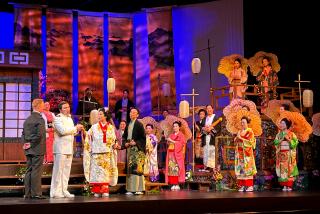L.A. Contemporary Dance Company
- Share via
All the clichés of bad modern dance were on display Saturday night when L.A. Contemporary Dance Company presented four world premieres in the first of a two-weekend run at Diavolo Dance Space. Omnipresent angst, frenzied flailing and headache-inducing soundtracks were but some of the offenses lobbed during the 90-minute show, “Modern Myths and Monsters.”
LACDC artistic director Kate Hutter contributed a pair of works, with company member Nichol Mason and guest choreographer Mecca Vazie Andrews also attempting to explore common themes described as “reinterpreting history, predicting the future and exposing myths” but mostly making use of the kitchen sink school of choreography.
Hutter’s “Clippings,” a perky duet between her and Kevin Williamson proved the least distasteful, perhaps because it was only five minutes. Their push-pull, love-hate quest for dominance also made good use of the pair’s Mutt-and-Jeff physicality. Hutter’s “HyperSuperUltraNow,” an octet set to a painful pastiche of synthesized music, was a 13-part, 30-minute foray into inanity. The work -- an interminable showcase for individual and group spasms, skitterings and leapings -- went nowhere slowly.
In “The Wagon Train Is Divided,” Vazie Andrews at least tried to tackle narrative, albeit unsuccessfully, in a work about social constructs of the late 1800s. This little dance on the prairie featured a cardboard well and performers in Puritan dress, save for Paulo Acedo as an inexplicable Harlequin, sprinkling fairy dust, and Devin Fulton as a temptress in a red, pouffy maillot.
When he was not being lured by a wildly cavorting Fulton, an able Michael Crotty partnered Cristine Diana Tatomer. A yearning duet between Jamila Glass and Marisa Jimenez also contributed to this strange scenario that received no help from a lackluster score by Sam Cooper and Michael Cameron.
Mason’s quartet, “Animus,” in plumbing the notion of “personal monstrosities,” was merely another jumble of feverish moves, including a battery of unisons and floor-rollings, with same-sex pairings (Mason and Natalie Hurter, Crotty and Williamson); intense, but never going far enough.
For modern dance to have an emotional connection, there must be a reason for the choreography, not simply steps for steps’ sake, no matter how wellexecuted.
More to Read
The biggest entertainment stories
Get our big stories about Hollywood, film, television, music, arts, culture and more right in your inbox as soon as they publish.
You may occasionally receive promotional content from the Los Angeles Times.










